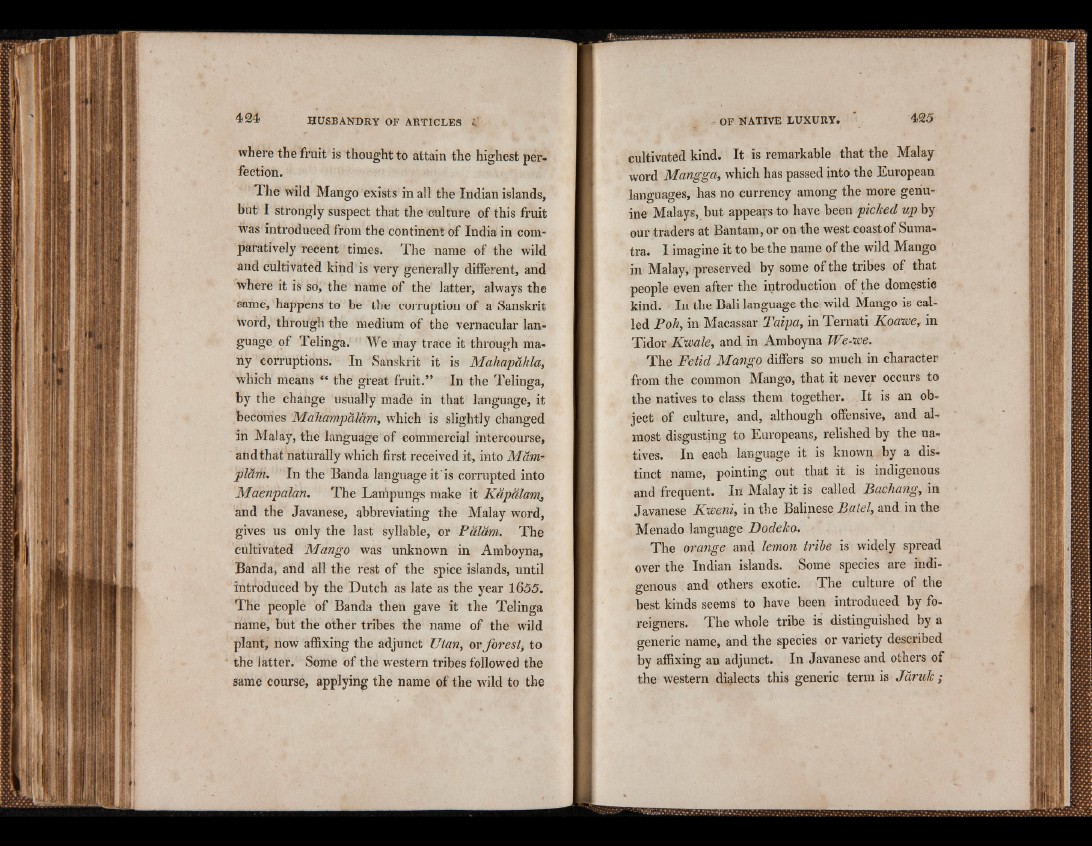
where the fruit is thought to attain the highest perfection.
The wild Mango exists in all the Indian islands,
but I strongly suspect that the culture of this fruit
was introduced from the continent of India in comparatively
recent times. The name of the wild
and cultivated kind is very generally different, and
where it is so, the name of the latter, always the
same, happens to be the corruption of a Sanskrit
word, through the medium of the vernacular language
pf Telinga. We may trace it through many
corruptions. In Sanskrit it is Mahapdhla,
which means “ the great fruit.” In the Telinga,
by the change usually made in that language, it
becomes Mafiampalam, which is slightly changed
in Malay, the language of commercial intercourse,
and that naturally which first received it, into Mcvm-
pl&m. In the Banda language it is corrupted into
Maenpalan. The Lampungs make it Kapalam^
and the Javanese, abbreviating the Malay word,
gives us only the last syllable, or Pdlam. The
cultivated Mango was unknown in Amboyna,
Banda, and all the rest of the spice islands, until
introduced by the Dutch as late as the year 1655.
The people of Banda then gave it the Telinga
name, but the other tribes the name of the wild
plant, now affixing the adjunct Utan, or forest, to
the latter. Some of the western tribes followed the
same course, applying the name of the wild to the
cultivated kind. It is remarkable that the Malay
word Mangga, which has passed into the European
languages, has no currency among the more genuine
Malays, but appears to have been picked up by
our traders at Bantam, or on the west coast of Sumatra.
I imagine it to be the name of the wild Mango
in Malay, preserved by some of the tribes of that
people even after the introduction of the domestic
kind. In the Bali language the wild Mango is called
Poh, in Macassar Taipa, in Ternati Koawe, in
Tidor Kwale, and in Amboyna We-we.
The Fetid Mango differs so much in character
from the common Mango, that it never occurs to
the natives to class them together. It is an object
of culture, and, although offensive, and almost
disgusting to Europeans, relished by the natives.
In each language it is known by a distinct
name, pointing out that it is indigenous
and frequent. In Malay it is called Bachang, in
Javanese Kweni, in the Balinese Patel, and in the
Menado language Dodeko.
The orange and lemon tribe is widely spread
over the Indian islands. Some species are indigenous
and others exotic. The culture of the
best kinds seems to have been introduced by foreigners.
The whole tribe is distinguished by a
generic name, and the species or variety described
by affixing an adjunct. In Javanese and others of
the western dialects this generic term is Jdruk ;